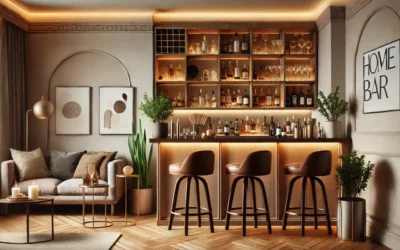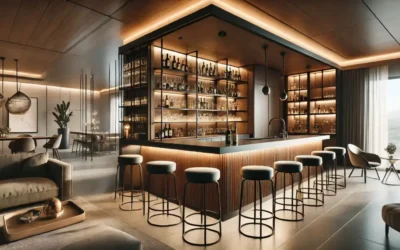Choosing custom kitchen cabinets can transform your kitchen into a space that reflects your personal style while maximizing functionality. However, to ensure your custom cabinets fit perfectly, it’s critical to measure your kitchen space accurately. In this guide, we will walk you through the process of measuring your kitchen for both custom kitchen cabinets and semi-custom kitchen cabinets, ensuring every inch of space is optimized.
Why Accurate Measurements Matter for Custom Kitchen Cabinets
The precise measurements of your kitchen are essential for several reasons. First, correct measurements will help you avoid ordering custom kitchen cabinets that don’t fit your space. Secondly, they ensure that every cabinet, drawer, and door operates without obstruction. Lastly, accurate measurements allow you to maximize storage and functionality, making your investment in wood furniture worthwhile.
Step 1: Measure the Width of Your Kitchen Walls
To begin, you’ll need a measuring tape, a pencil, and a sheet of graph paper or a measuring app on your device.
- Start by measuring the width of each wall where you plan to install the cabinets. Measure from corner to corner.
- Write down the exact measurements in inches or centimeters.
- If your walls have any windows, doors, or structural elements (such as columns), measure their width and height separately. Subtract these from the total wall width to calculate the usable space.
For semi-custom kitchen cabinets, ensuring accurate wall measurements is vital because, while they offer some flexibility, they’re not as adaptable as custom kitchen cabinets.
Step 2: Measure the Height of Your Walls
Next, measure the height of the wall from the floor to the ceiling. Most standard kitchens have ceilings ranging between 8 to 10 feet high, but you’ll need to verify your specific kitchen height.
- Take a vertical measurement from the floor to the ceiling at multiple points along the wall. Sometimes floors are uneven, so you’ll want to identify any variations in height.
- Record the shortest measurement, as this will guide the height of your cabinets. This precaution ensures that your cabinets won’t end up too tall for the lowest part of your ceiling.
Step 3: Mark the Location of Key Appliances and Fixtures
To create a seamless kitchen layout, it’s essential to note the placement of major appliances, sinks, and any existing wood furniture that you plan to incorporate into the kitchen design.
- Measure the width, height, and depth of all your major kitchen appliances, such as the refrigerator, oven, and dishwasher. These measurements ensure that your custom kitchen cabinets are designed to leave enough room for installation and ventilation around appliances.
- Make note of any plumbing fixtures and electrical outlets. This is particularly important if you’re installing a sink or a stovetop in your new cabinetry.
Step 4: Measure for Corner Cabinets
If your kitchen layout includes corners, measuring them accurately is crucial for creating functional and aesthetically pleasing cabinetry. Corner cabinets, whether they’re custom kitchen cabinets or semi-custom kitchen cabinets, require additional space for easy access.
- Measure the distance from the corner of the wall to the nearest opening (such as a window, door, or appliance).
- Ensure that you account for space needed to open doors and drawers without obstruction.
Step 5: Check for Flooring and Ceiling Issues
If you’re planning on installing bathroom vanities from floor to ceiling, you need to check for any flooring or ceiling irregularities. Uneven flooring can cause problems when installing base cabinets, and unlevel ceilings may affect the look of upper cabinets.
- Measure the height of your flooring at multiple points to see if it is level.
- Check your ceiling for any variations in height by measuring at different points.
- If there are irregularities, communicate these details to your cabinet maker to ensure your cabinets are designed with the appropriate adjustments.
Step 6: Measure the Depth of Your Kitchen Cabinets
The depth of your custom kitchen cabinets is another critical factor. Standard base cabinets are usually 24 inches deep, but semi-custom kitchen cabinets may offer more flexibility in terms of depth.
- Measure the depth of your existing countertops if you plan on keeping them.
- Consider the depth of any custom cabinetry that will go over appliances such as the refrigerator or range.
- If you’re planning for a kitchen island, ensure that you leave enough space for movement between the island and surrounding cabinets.
Step 7: Confirming the Layout with a Professional
Once you’ve collected all your measurements, it’s a good idea to review them with a professional cabinet maker or designer who specializes in custom kitchen cabinets. They can double-check your work, suggest improvements, and create a detailed plan for the cabinetry installation. Working closely with a professional ensures that your cabinets are designed to maximize both style and storage. It also ensures that any issues related to plumbing, electrical work, or structural challenges are resolved early in the process.
Common Mistakes to Avoid When Measuring for Custom Kitchen Cabinets
While measuring may seem straightforward, some common mistakes can lead to complications during the installation process:
- Ignoring Ceiling and Floor irregularities Slight variations in height can lead to gaps between your cabinets and the ceiling or floors.
- Not Accounting for Appliance Clearances: Make sure to leave enough space for appliance doors to open fully.
- Inaccurate Corner Measurements: Corners often cause issues in kitchen design if they aren’t measured precisely.
- Failing to Measure Twice: Always measure twice before recording your dimensions to ensure accuracy.
Choosing Between Custom and Semi-Custom Kitchen Cabinets
Now that you understand how to measure your space for cabinetry, it’s important to decide whether custom kitchen cabinets or semi-custom kitchen cabinets are right for you.
- Custom Kitchen Cabinets are built to the exact specifications of your kitchen. They allow for complete customization in terms of materials, finishes, and layout. They’re ideal for homeowners who want to make the most of every inch of their kitchen space.
- Semi-Custom Kitchen Cabinets offer more flexibility than stock cabinets but don’t provide the same level of personalization as fully custom options. They are typically more affordable than custom cabinetry and work well for kitchens with more standard layouts.
Both options can result in beautiful kitchens, but the decision will ultimately depend on your budget, your design preferences, and the specific needs of your kitchen.
Final Thoughts
Measuring your kitchen correctly is the first step toward creating a functional and aesthetically pleasing space. Whether you’re opting for custom kitchen cabinets or semi-custom kitchen cabinets, following these measurement steps will ensure that your cabinets fit perfectly and operate smoothly. Once you have your measurements, working with a professional will help you bring your vision to life, resulting in a kitchen you’ll love for years to come.



